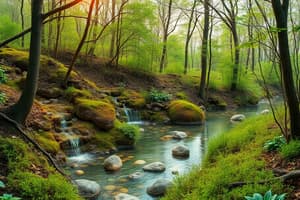Podcast
Questions and Answers
What is the primary role of decomposers in an ecosystem?
What is the primary role of decomposers in an ecosystem?
- To produce energy through photosynthesis
- To regulate the population of herbivores
- To compete with predators for resources
- To break down dead matter and return nutrients to the soil (correct)
What effect does the removal of a keystone predator, like wolves, have on an ecosystem?
What effect does the removal of a keystone predator, like wolves, have on an ecosystem?
- It can lead to overpopulation of herbivores, causing overgrazing. (correct)
- It decreases plant growth significantly.
- It decreases the diversity of plant species.
- It has no significant impact on herbivore populations.
In a food web, what does a pyramid of biomass represent?
In a food web, what does a pyramid of biomass represent?
- The total mass of organisms at each trophic level (correct)
- The number of species at each trophic level
- The distribution of organisms across different biomes
- The amount of energy available at each trophic level
Which of the following best describes carrying capacity?
Which of the following best describes carrying capacity?
Which level of ecological hierarchy includes both living and abiotic factors?
Which level of ecological hierarchy includes both living and abiotic factors?
What is the primary abiotic factor in the nitrogen cycle?
What is the primary abiotic factor in the nitrogen cycle?
Which of the following correctly describes the energy flow in a food chain?
Which of the following correctly describes the energy flow in a food chain?
What does the 10% rule in energy dynamics refer to?
What does the 10% rule in energy dynamics refer to?
Which of the following statements is true regarding the flow of matter in an ecosystem?
Which of the following statements is true regarding the flow of matter in an ecosystem?
In which of the following cycles does carbon move from the atmosphere to living organisms?
In which of the following cycles does carbon move from the atmosphere to living organisms?
What role do decomposers play in an ecosystem?
What role do decomposers play in an ecosystem?
Why is energy considered to flow one direction in an ecosystem?
Why is energy considered to flow one direction in an ecosystem?
Which of the following correctly identifies a biotic factor in the carbon cycle?
Which of the following correctly identifies a biotic factor in the carbon cycle?
Study Notes
Biogeochemical Cycles
- Interactions between the biosphere, geosphere, atmosphere, and hydrosphere create biogeochemical cycles like the carbon, nitrogen, and water cycles.
- Biotic factors are living components (plants, animals, microbes), while abiotic factors are non-living elements (sunlight, water, minerals).
- In the nitrogen cycle, nitrogen-fixing bacteria are a biotic factor, and soil and atmospheric nitrogen are abiotic factors.
Matter Recycling in Ecosystems
- Matter is continuously cycled within ecosystems, being used, transformed, and reused.
- In the carbon cycle, plants absorb CO2 through photosynthesis, animals consume plants, and decomposers break down dead organisms, returning carbon to the soil or releasing it back to the atmosphere.
Energy Flow and the 10% Rule
- Energy flows in one direction, starting from the sun and moving through producers and consumers.
- Energy is not recycled; once used by organisms, it is lost as heat and must be continually replenished by the sun.
- The 10% rule states that only about 10% of energy is transferred from one trophic level to the next. The remaining 90% is lost as heat or used for metabolic processes.
Food Chains and Food Webs
- A food chain depicts the linear flow of energy through different organisms (e.g., grass → rabbit → fox).
- A food web shows the interconnectedness of multiple food chains, illustrating complex feeding relationships and energy flow within an ecosystem.
Trophic Levels and Decomposers
- Trophic levels represent feeding positions in a food chain:
- Producers: Plants
- Primary consumers: Herbivores
- Secondary consumers: Carnivores that eat herbivores
- Tertiary consumers: Top predators
- Decomposers: Break down dead matter
- Decomposers (fungi, bacteria) and detritivores (earthworms, vultures) break down dead matter, returning nutrients to the soil, sustaining producers and maintaining nutrient cycles.
Ecological Hierarchy
- Ecological hierarchy refers to the levels of organization within an ecosystem:
- Organism: Individual living thing
- Population: Group of organisms of the same species in an area
- Community: Interacting populations of different species
- Ecosystem: Community interacting with its abiotic environment
- Biome: Collection of similar ecosystems (e.g., deserts, forests)
- Biosphere: All ecosystems on Earth
Population Size and Carrying Capacity
- Population size is influenced by birth rates, death rates, immigration, and emigration.
- Carrying capacity refers to the maximum number of individuals an environment can sustain over time, limited by resources such as food, water, and shelter.
Pyramids of Numbers, Biomass, and Energy
- Pyramid of numbers: Represents the number of organisms at each trophic level.
- Pyramid of biomass: Shows the total mass of organisms at each trophic level.
- Pyramid of energy/trophic levels: Depicts the decreasing amount of energy available as you move up through trophic levels.
Food Web Disruptions and Consequences
- Removing or adding species to a food web can have ripple effects on other organisms.
- For example, removing a keystone predator like wolves can cause an overpopulation of deer, which can overgraze plants, reducing food for other herbivores and disrupting the ecosystem balance.
Studying That Suits You
Use AI to generate personalized quizzes and flashcards to suit your learning preferences.
Description
Explore the intricate interactions between biotic and abiotic factors in biogeochemical cycles, such as carbon and nitrogen cycles. Understand how matter is recycled in ecosystems and the significance of energy flow, including the 10% rule. This quiz will test your knowledge on these fundamental ecological concepts.




